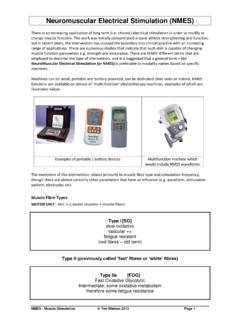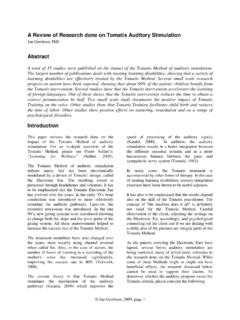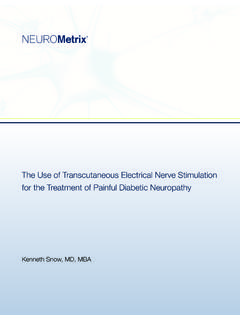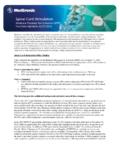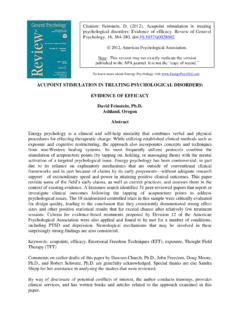Transcription of Efficacy of an evidence-based cognitive stimulation ...
1 BackgroundBackgroundArecent CochraneArecent Cochranereview of reality orientation therapyreview of reality orientation therapyidentifiedthe need forlarge, well-identifiedthe need forlarge, well-designed, multi-centre , multi-centre te s t th e hyp oth e sis th atTotestthe hypothesis thatcognitive stimulation therapy (CST) forcognitive stimulation therapy (CST) forolder people with dementia would benefitolderpeoplewith dementiawouldbenefitcognition and quality of and quality of single-blind, multi-centre,A single-blind, multi-centre,randomised controlled trialrecruited 201randomised controlledtrialrecruited 201older people with mainolder people with mainoutcome measureswere changeinoutcome measures were changeincognitive function and quality of life.
2 Ancognitive function and quality of life. Anintention-to-treat analysisused analysis ofintention-to-treat analysisused analysis ofcovariance to control for potentialcovariance to control for potentialvariability in baseline baseline hundred and fifteenOne hundred and fifteenpeoplewererandomisedwithincentres topeoplewererandomisedwithin centres tothe intervention group and 86 to thethe intervention group and 86 to thecontrol group. At follow-up thecontrol group. At follow-up theintervention group had significantlyintervention group had significantlyimprovedrelativetothe controlgroup onimprovedrelativetothe controlgroup onthe Mini-Mental State Examinationthe Mini-Mental State Examination((PP ), the Alzheimer s ), the Alzheimer s DiseaseAssessment Scale ^ Cognition (ADAS^Assessment Scale ^ Cognition (ADAS^Cog) (Cog) (PP ) and Quality of Life ^ ) and Qualityof Life ^Alzheimer s Disease scales (Alzheimer s Disease scales (PP ).)
3 Using criteria of 4 points or moreUsing criteria of 4 points or moreimprovement on the ADAS^Cog theimprovement on the ADAS ^Cog thenumberneededtotreat was 6 for thenumber neededtotreat was 6 for theintervention withtrials ofdrugs withtrials ofdrugs groupsmayhaveworthwhilebenefitsCST groupsmayhaveworthwhile of interestDeclaration of detailedin detailedin treatments for dementia,Psychological treatments for dementia,such as reality orientation, have been insuch as reality orientation, have been inuse for nearly half a century (Taulbee &use for nearly half a century (Taulbee &Folsom, 1966).)
4 Despite their longevity,Folsom, 1966). Despite their longevity,their effects remain open to question andtheir effects remain open to question andmany studies have been either small, ofmany studies have been either small, ofpoor methodological quality, or bothpoor methodological quality, or both(Orrell & Woods, 1996). Reality orientation(Orrell & Woods, 1996). Reality orientationoperates through the presentation andoperates through the presentation andrepetition of orientation information, eitherrepetition of orientation information, eitherthroughout the day ( 24-hour ) or in groupsthroughout the day ( 24-hour ) or in groupsmeeting on a regular basis to engage inmeeting on a regular basis to engage inorientation-related activities ( classroom )orientation-related activities ( classroom )(Brook(Brooket alet al, 1975).
5 A recent Cochrane, 1975). A recent Cochranereview found that reality orientation wasreview found that reality orientation wasassociated with significant improvementsassociated with significant improvementsin both cognition and behaviour, but alsoin both cognition and behaviour, but alsoidentified a need for large, well-designed,identified a need for large, well-designed,multi-centre trials (Spectormulti-centre trials (Spectoret alet al, 1998,, 1998,2000). The results of the Cochrane review2000). The results of the Cochrane reviewwere used to develop a programme ofwere used to develop a programme ofevidence- based therapy focused on cogni- evidence - based therapy focused on cogni-tive stimulation (Spectortive stimulation (Spectoret alet al, 2001).
6 The, 2001). Thecognitive stimulation therapy was pilotedcognitive stimulation therapy was pilotedin three care homes and one day centre,in three care homes and one day centre,leading to improvements in cognition andleading to improvements in cognition anddepression for people participating in thedepression for people participating in theprogramme compared with the controlprogramme compared with the controlgroup (Spectorgroup (Spectoret alet al, 2001). The aim of, 2001). The aim ofthe study reported here was to evaluatethe study reported here was to evaluatethe effects of cognitive stimulation therapythe effects of cognitive stimulation therapygroups on cognition and quality of life forgroups on cognition and quality of life forpeople with dementia, in a single-blind,people with dementia, in a single-blind,multi-centre, randomised controlled trialmulti-centre, randomised controlled trial(RCT).
7 (RCT).METHODMETHODP articipantsParticipantsA total of 169 day centres and residentialA total of 169 day centres and residentialhomes with a minimum of 15 residentshomes with a minimum of 15 residentseach (to maximise numbers of suitableeach (to maximise numbers of suitableparticipants) were contacted in the parti-participants) were contacted in the parti-cipating areas (the National Health Servicecipating areas (the National Health ServiceTrusts for Barking, Havering and Brent-Trusts for Barking, Havering and Brent-wood, Tower Hamlets, Enfield, andwood, Tower Hamlets, Enfield, andCamden and Islington, as well as QuantumCamden and Islington, as well as QuantumCare, a voluntary organisation in Hertford-Care, a voluntary organisation in Hertford-shire).)
8 The researchers investigated allshire). The researchers investigated allinterested centres (day centres and resi-interested centres (day centres and resi-dential homes) to determine whether theredential homes) to determine whether therewere adequate numbers of potential parti-were adequate numbers of potential parti-cipants with dementia, by using an inclu-cipants with dementia, by using an inclu-sion criteria flow chart. A minimum ofsion criteria flow chart. A minimum ofeight or more eligible people were requiredeight or more eligible people were requiredin each centre, because five were needed forin each centre, because five were needed forthe group, leaving three or more controlthe group, leaving three or more criteriaInclusion criteriaPeople were considered suitable for fullPeople were considered suitable for fullassessment and participation if they:assessment and participation if they.
9 (a)(a) met the DSM IV criteria for dementiamet the DSM IV criteria for dementia(AmericanPsychiatricAssociation, (AmericanPsychiatricAssociation,1994);19 94);(b)(b) scored between 10 and 24 on the Mini-scored between 10 and 24 on the Mini-Mental State Examination (MMSE;Mental State Examination (MMSE;FolsteinFolsteinet alet al, 1975);, 1975);(c)(c) had some ability to communicate andhad some ability to communicate andunderstand communication a scoreunderstand communication a scoreof 1 or 0 in questions 12 and 13 ofof 1 or 0 in questions 12 and 13 ofthe Clifton Assessment Procedures forthe Clifton Assessment Procedures forthe Elderly Behaviour Rating Scalethe Elderly Behaviour Rating Scale(CAPE BRS; Pattie & Gilleard, 1979);(CAPE BRS; Pattie & Gilleard, 1979).
10 (d)(d) were able to see and hear well enoughwere able to see and hear well enoughto participate in the group and maketo participate in the group and makeuse of most of the material in theuse of most of the material in theprogramme, as determined by theprogramme, as determined by theresearcher;researcher;(e)(e) did not have major physical illnessdid not have major physical illnessordisabilitywhichcouldaffectordis abilitywhichcouldaffectparticipation;par ticipation;(f)(f) did not have a diagnosis of a learningdid not have a diagnosis of a and processDesign and processof randomisationof randomisationIn residential homes and day centres with atIn residential homes and day centres with atleast eight suitable participants, full assess-least
